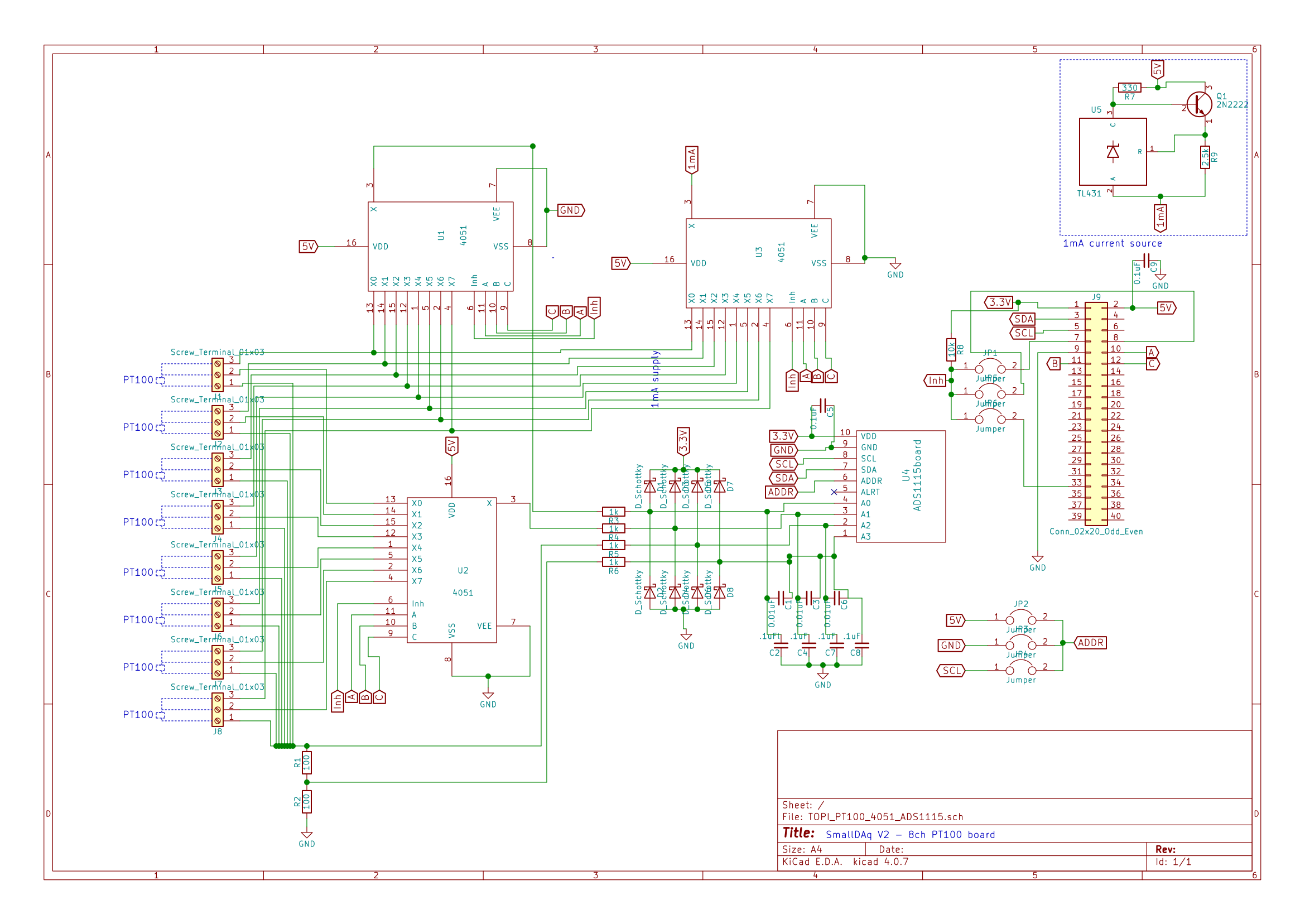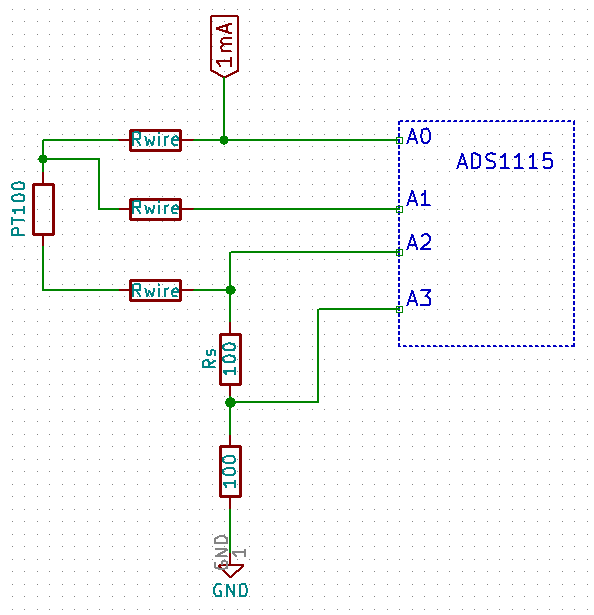[latexpage]
I wanted to readup multiple PT100 with high accuracy. The features are:
- Controlled current source using TL413 to avoid self-heating.
- 3 wire PT100 with wire resistance compensation.
- Ratiometric measurement.
- Amplification of signal to get good resolution – hence ADS1115.
- Multiplexing with HC4051.
I went through various designs, searched a lot over the internet but only found few references. Main question was – can the HC4051 be the right choice as a multiplexer. Also if TL431 will give stable current. The always helpful online community at Stack Exchange helped me immensely and directly. Here is my post and discussion over there. I modified the solutions and here is the currently adopted one. Designed in KiCAD.

So the way it goes is:
- A single TL431 (right top corner) supplies 1mA.
- This 1 mA is multiplexed by a 4051 – U3 on the schematic to the 8 PT100s. Since its a constant current source, the on resistance (Ron) of 4051 would not matter or change anything.
- I need to measure the input voltages of the 1st wire of the 3-wire (starting from top to bottom) PT100s. So another 4051 – U1 does that. Here, since i am only measuring the voltage using a high impedance ADS1115 (6 MOhm i read somewhere) there is no current flowing through the 4051 so no voltage drop, hence Ron is not important here too.
- Then the monitored 1mA current passes through the PT100 1st wire and can be sensed by the 2nd wire using another 4051. Again since there is no current passing due to high impedance inputs of ADS1115, no potential drop across Ron of 4015 is expected. The difference between the previous measurement (point 3) and this one gives me the potential drop across the wire for a constant current flow = wire resistance!
- Finally the 1mA passes through the PT100 and emerges onto a series of 100 ohm resistances. The potential drop across the top 100 ohm resistance is measured again. Since this 100 ohm resistance is 1% accuracy i can compute the current passing through accurately enough. So variations in the current source (TL431) can now be neglected. This also makes the whole thing ratiometric, as explained below.
- I didnt want to short the 4rth measurement terminal of the ADS1115 to the ground because of a fear that it would lead to ground loops. So i put in a 100 ohm resistor there. I am purely guessing over here. Maybe a higher resistance must be used than 100 ohm, but that should not overload the TL431 supply.
So how does one measure the PT100 after all the above steps? The above schematic is simplified here where a single PT100 interfaces the ADS1115. Note that Rwire is the resistance due to long PT100 wires and is an inherent part of the PT100. The ADS1115 has 4 analog inputs and has a special mode in which each of the 1st three – A0, A1, A2 can be measured differentially with A3. This is what we will use.

First we must measure the circuit excitation current $I_{ex}$ flowing through the circuit:
\begin{equation} \label{eq:Iex}
I_{ex} = \frac{V_{A_2-A_3}}{R_s}
\end{equation}
$R_s$ is a known value, in this cas of 100 $\ohm$. Secondly, the $R_{wire}$ can be deduced using following equation. Note that $I_{ex}$ is not passing through $R_{wire}$ of the wire leading to the A1 pin because A1 is high impedance.
\begin{equation} \label{eq:Rwire}
R_{wire} = \frac{V_{A_0-A_3} – V_{A_1-A_3}}{I_{ex}}
\end{equation}
Further, the relation between the voltages at A1 and A2 and the Pt100 can be put as:
\begin{equation} \label{eq:RwirePt100}
R_{wire} + R_{PT100} = \frac{V_{A_1-A_3} – V_{A2-A3}}{I_{ex}}
\end{equation}
Using eq.\ref{eq:Iex} and eq.\ref{eq:Rwire} in eq. \ref{eq:RwirePt100}, a simplified form emerges:
\begin{equation} \label{eq:Pt100}
R_{PT100} = \frac{2 \times V_{A_1-A_3} – V_{A2-A3} – V_{A1-A3} }{V_{A2-A3}} \times R_s
\end{equation}
Note that its a ratio of two voltage units, so bacically the 16bit raw outputs (CODE) of ADS1115 could be used:
\begin{equation} \label{eq:Pt100CODE}
R_{PT100} = \frac{2 \times CODE_{A_1-A_3} – CODE_{A2-A3} – CODE_{A1-A3} }{CODE_{A2-A3}} \times R_s
\end{equation}
Conversion to temperature is simple, and i have used an equation obtained from this excellent source:
and reproduced here.
\begin{equation} \label{eq:T}
T_{PT100} = -244.83 + R_{PT100} \times ( 2.3419 + 0.0010664 \times R_{PT100} )
\end{equation}
So far it works. Need to check this in the full range of 0-200 $\deg$C.
The circuit above has additional components to protect the inputs of ADS1115 as well as filter the input. The filter values have been shamelessly copied from other sources which im stupid enough to not remember or note anywhere, sorry.
Very interesting, I would want to adjust this to a 2-Wire pt1000 setup since we have very short wires, any chance you could share the KiCad file?
Dear Sir, Your Main Equation has Mistake, Kindly Make Corrections: (R_{PT100} = \frac{2 \times CODE_{A_1-A_3} – CODE_{A2-A3} – CODE_{A0-A3} }{CODE_{A2-A3}} \times R_s) . I have Implemented Same Circuit Thanks to You and Working like a charm with CD4067 16 Channel Multiplexer IC.
Additional sources for More curios people:
1. https://e2e.ti.com/support/data-converters-group/data-converters/f/data-converters-forum/528431/issues-using-ads1118-and-3-wire-rtd-pt1000-in-wheatstone-configuration
2. https://www.ti.com/lit/an/sbaa275a/sbaa275a.pdf